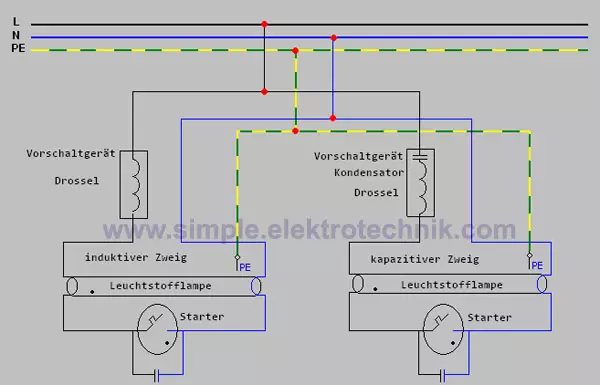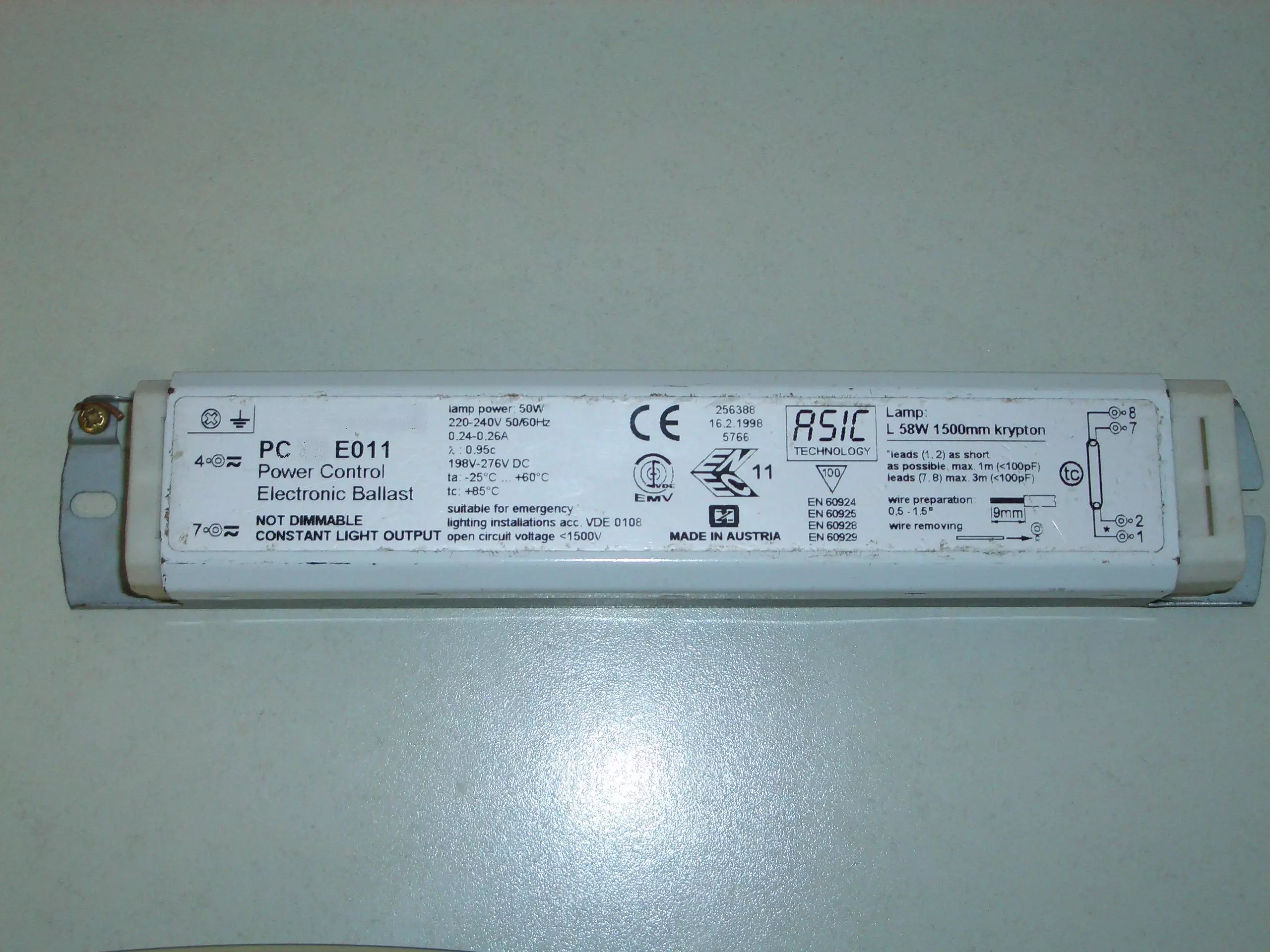Instructions for Wiring and Testing a DUO Circuit for Fluorescent Lamps
A DUO circuit, also known as a dual ballast circuit or two-circuit, is a special type of circuit used for lighting with fluorescent lamps. In a DUO circuit, two fluorescent lamps are operated, with one connected through an inductive ballast (choke coil) and the other through a capacitive ballast (capacitor).
The purpose of the DUO circuit is to make the operation of fluorescent lamps more efficient and flicker-free. By using both inductive and capacitive ballasts, phase shifting of the current is eliminated, which normally occurs in individual ballasts. This results in an overlap of the bright and dark periods of the lamps, avoiding flickering and the stroboscopic effect.
Structure and Function of a DUO Circuit for Fluorescent Lamps:
The DUO circuit allows for the simultaneous operation of two fluorescent lamps, with one lamp being operated through an inductive ballast and the other being driven by a capacitive ballast.
This combination creates a parallel connection of the two circuits, eliminating the phase shift of the current. The result is a high power factor of approximately 0.95.

The high power factor is of great importance as it ensures that there is no overlap of the bright and dark periods of the lamps, effectively avoiding flickering and the stroboscopic effect. These undesired effects can otherwise occur at low power factors and negatively impact the visual perception of the lighting.
Therefore, the DUO circuit offers an efficient solution for lighting with fluorescent lamps, ensuring a stable and flicker-free light source. By optimally utilizing the inductive and capacitive ballasts, harmonious operation of the lamps is ensured, resulting in pleasant and uniform illumination.
In summary, the DUO circuit enables the operation of two fluorescent lamps with phase shift cancellation and a high power factor. This leads to a reliable, flicker-free, and pleasant lighting environment.
Circuit Diagram of DUO Circuit

Wiring a DUO Circuit:
Wiring a DUO circuit requires proper connection of the individual components. The following steps should be followed to ensure smooth operation:

- Connecting the fluorescent lamps to the ballasts:
The fluorescent lamps should be connected to the respective ballasts according to the connection diagrams. Ensure that the correct connections are used to cancel the phase shift. - Parallel connection of the ballasts:
Once the fluorescent lamps are correctly connected, the ballasts should be connected in parallel. This means connecting the inputs of all ballasts together and similarly connecting the outputs. This ensures that the current is evenly distributed to the lamps. - Connection to the power supply:
Now, connect the parallel-connected ballasts to the power supply. Ensure a secure and reliable connection. It is recommended to interrupt the power supply beforehand to minimize the risk of electrical shocks.
Careful wiring ensures not only smooth operation of the DUO circuit but also the safety of all users. Therefore, don't forget to thoroughly check all connections before commissioning the circuit.
Please note that this is a general guide. For specific information and detailed connection diagrams, refer to the manufacturer's documentation or seek expert assistance.
Function Test of a DUO Circuit:
To ensure that the DUO circuit is functioning properly, it is recommended to perform a thorough function test. This ensures not only the correct wiring but also optimal performance. Below is a step-by-step guide on how to perform the function test of the DUO circuit.

- Check the wiring:
First, make sure that the wiring of the DUO circuit is done correctly. Carefully inspect all connections to ensure they are properly connected. Incorrect wiring can lead to malfunctions. Ensure that the power supply is turned off before starting the inspection. - Turn on the power supply:
Turn on the power supply and observe if both fluorescent lamps ignite properly. Make sure they operate without flickering. Flickering light or inadequate ignition may indicate a problem. - Measure the power factor:
To ensure the efficient operation of the DUO circuit, it is advisable to measure the power factor. A high power factor, close to 0.95, indicates that the circuit efficiently utilizes energy. Use an appropriate measuring device to determine the power factor. If the value deviates significantly from 0.95, it may indicate a faulty circuit.
If any issues arise during the function test, identify possible sources of errors. Double-check the wiring to ensure that all components are correctly connected.
Also, pay attention to the polarity of the connections. Furthermore, it may be helpful to test the functionality of the lamps used. Replace any defective lamps if necessary.
By conducting a careful function test, you can ensure that the DUO circuit is operating properly and achieving optimal results. Regularly check the functionality to identify and address any potential issues early on.

Advantages and Disadvantages of a DUO Circuit:
The DUO circuit offers several advantages. Firstly, it enables an economical lighting system by improving power factors and optimizing energy consumption.
Secondly, it ensures flicker-free and instant ignition of fluorescent lamps, enhancing visual comfort. Additionally, there is no humming sound, and the stroboscopic effect is eliminated, resulting in pleasant and stable lighting.
Advantages of a DUO Circuit:
- Improved performance: A DUO circuit provides several advantages over conventional circuits. It allows for improved performance and efficiency by utilizing two separate circuits to distribute the load evenly. This enables more effective energy utilization, leading to higher performance.
- Redundancy and reliability: A DUO circuit also offers the advantage of redundancy as it consists of two independent circuits. In case of failure or malfunction in one of the circuits, the functions can still be maintained through the other circuit. This increases reliability and reduces the likelihood of interruptions or downtime.
- Flexibility and adaptability: A DUO circuit allows for the operation of different components or devices within a system. By using two separate circuits, various voltages or frequencies can be handled within a system, providing greater flexibility and adaptability. This is particularly beneficial in situations where different requirements are placed on the system.
- Flicker-free and instant ignition of fluorescent lamps: Thanks to the DUO circuit, flickering and delays in lamp ignition are avoided. This results in immediate and reliable illumination without any disturbing effects.
- No humming sound: Unlike some other types of circuits, the DUO circuit does not produce any humming or other disruptive noises. The lighting remains quiet and pleasant.
- No stroboscopic effect: The use of a DUO circuit eliminates the stroboscopic effect that can occur with some fluorescent lamps.
Disadvantages of a DUO Circuit:
- Complexity and cost: A DUO circuit is typically more complex than conventional circuits. This can lead to higher costs in development, implementation, and maintenance. Additionally, special components or parts may be required to support the functionality of the DUO circuit. These additional costs should be considered when deciding on a DUO circuit.
- Space requirement: Due to the use of two separate circuits, a DUO circuit usually requires more space than a conventional circuit. This can be an issue when space is limited, such as in compact electronic devices or systems. Therefore, the space requirement should be taken into account during the planning and design of a system.
- Compatibility issues: When using a DUO circuit, compatibility issues may arise between the two circuits. Different voltages, frequencies, or signal levels can affect the functionality or cause disruptions. Therefore, it is important to carefully consider compatibility when selecting and integrating components, and to identify potential issues early on.
Despite some potential disadvantages, a DUO circuit offers improved performance, redundancy, and flexibility. It is important to consider the specific requirements and constraints of the system to decide if a DUO circuit is the right choice.
Comparison: Conventional Ballast vs. Electronic Ballast
In the lighting industry, conventional ballasts are being increasingly replaced by electronic ballasts (EBs). This development is due to the numerous advantages that EBs offer.
One main advantage of EBs lies in their improved energy efficiency. With their higher frequency, they convert electricity more efficiently and reduce energy losses compared to conventional ballasts. This results in lower energy consumption, which reduces costs and is more environmentally friendly.
Another important aspect is the flicker-free light produced by EBs. Unlike conventional ballasts, fluorescent lamps operated with EBs start instantly without visible flickering. This flicker-free lighting significantly improves visual comfort and reduces eye strain, especially during prolonged use.
Furthermore, EBs contribute to a longer lifespan of fluorescent lamps. Through smoother and gentler operation, the lamps are less stressed, increasing their durability. As a result, they require less frequent replacement, saving costs and effort.
EBs also offer more flexibility. They often feature additional functions such as dimming capability and the ability to connect different types of fluorescent lamps. This allows for more precise customization of the lighting to specific requirements and provides greater control over the lighting environment.
Lastly, from an ecological perspective, EBs are advantageous. Their higher energy efficiency and the longer lifespan of lamps contribute to reducing energy consumption and waste. The use of EBs is a step towards sustainability and environmental protection.
Overall, electronic ballasts are an advanced and recommended alternative to conventional ballasts. Their benefits in terms of energy efficiency, flicker-free light, longer lamp lifespan, flexibility, and environmental friendliness make them the preferred choice for lighting with fluorescent lamps. By using EBs, businesses can reduce costs, enhance comfort, and contribute to environmental conservation.
Electronic Ballast (EB)

Elektrosicherheit: Richtlinien und Vorsichtsmaßnahmen für einfache elektrotechnische Arbeiten
Die Sicherheit hat oberste Priorität.

- Alle hier bereitgestellten Anleitungen und Informationen dienen rein informativen Zwecken und sollen ausschließlich zur Informationsbeschaffung und Weiterbildung verwendet werden. Sie sollten nicht als Ersatz für professionelle Beratung angesehen werden. Bei Zweifeln empfiehlt es sich, einen qualifizierten Elektriker hinzuzuziehen, um fachkundige Unterstützung zu erhalten.
- Es ist wichtig, die örtlichen Vorschriften und Bestimmungen bei elektrischen Arbeiten zu beachten. Arbeiten mit Strom sollten nur von qualifizierten Fachleuten durchgeführt werden, da sie lebensgefährlich sein können.
- Fehler in Anleitungen und Schaltbildern sind möglich. Der Anbieter übernimmt keine Gewähr oder Haftung für Schäden oder Verletzungen, die aus der Umsetzung der bereitgestellten Informationen resultieren könnten. Es liegt in Ihrer Verantwortung, die Richtigkeit der Informationen zu überprüfen und die erforderlichen Sicherheitsvorkehrungen zu treffen.
- Die Verwendung geeigneter persönlicher Schutzausrüstung (PSA) ist entscheidend, um die Sicherheit bei elektrotechnischen Arbeiten zu gewährleisten. PSA schützt vor Stromschlägen, Augenverletzungen, thermischen und mechanischen Gefahren. Es ist jedoch wichtig zu beachten, dass PSA allein nicht ausreicht und durch Fachwissen, Fähigkeiten und die Einhaltung von Sicherheitsvorschriften ergänzt werden muss.
- Arbeiten an Teilen, die unter Spannung stehen, sind strengstens untersagt. Vor Beginn der Arbeiten müssen geeignete Sicherheitsvorkehrungen getroffen werden, einschließlich des Freischaltens der Anlage.
- Bei Schäden durch mangelhafte Elektroinstallation haftet der Errichter der Anlage gemäß den geltenden gesetzlichen Bestimmungen.
- Diese Zusammenfassung von Richtlinien und Vorsichtsmaßnahmen ist nicht umfassend. Bei Unsicherheiten ist es ratsam, einen qualifizierten Elektriker zu konsultieren oder sich an örtliche Vorschriften und Bestimmungen zu halten, um maximale Sicherheit zu gewährleisten.
- Die ordnungsgemäße Installation und Wartung von elektrischen Anlagen und Geräten ist von großer Bedeutung, um mögliche Gefahren zu minimieren und ein sicheres Umfeld zu schaffen.
Hier sind einige wichtige Begriffe aus der Elektrotechnik mit kurzen Erläuterungen:
Strom
Der Strom ist die elektrische Ladung, die pro Zeiteinheit durch einen elektrischen Leiter fließt. Er wird in Ampere (A) gemessen.
Spannung
Die Spannung ist die elektrische Potentialdifferenz zwischen zwei Punkten in einem elektrischen Stromkreis. Sie wird in Volt (V) gemessen und ist verantwortlich für den Stromfluss.
Widerstand
Der Widerstand ist ein Maß für die Fähigkeit eines Bauteils oder Leiters, den Stromfluss zu behindern. Er wird in Ohm (Ω) gemessen und folgt dem Ohmschen Gesetz.
Leistung
Die Leistung ist die Menge an Arbeit pro Zeiteinheit, die in einem elektrischen System verrichtet oder übertragen wird. Sie wird in Watt (W) gemessen und berechnet sich als das Produkt aus Strom und Spannung.
Ohmsches Gesetz
Das Ohmsche Gesetz besagt, dass der Strom durch einen elektrischen Leiter proportional zur angelegten Spannung und umgekehrt proportional zum Widerstand ist: I = U/R.
Kirchhoffsche Gesetze
Die Kirchhoffschen Gesetze sind grundlegende Prinzipien in der elektrischen Schaltungstechnik. Das erste Gesetz besagt, dass in einem Knotenpunkt eines Stromkreises die Summe der eingehenden Ströme gleich der Summe der ausgehenden Ströme ist. Das zweite Gesetz besagt, dass in einer geschlossenen Schleife die Summe der Spannungsabfälle gleich der Summe der Spannungsquellen ist.
Gleichstrom (DC)
Gleichstrom ist ein elektrischer Strom, bei dem die Richtung des Stromflusses konstant ist.
Wechselstrom (AC)
Wechselstrom ist ein elektrischer Strom, bei dem die Richtung des Stromflusses periodisch wechselt. In den meisten Haushalten und in der öffentlichen Stromversorgung wird Wechselstrom verwendet.
Frequenz
Die Frequenz ist die Anzahl der Perioden (Schwingungen) pro Zeiteinheit in einem periodischen Signal. In der Elektrotechnik wird sie in Hertz (Hz) gemessen.
Phasenverschiebung
Die Phasenverschiebung ist der zeitliche Unterschied zwischen zwei periodischen Signalen, die in der Regel sinusförmig sind. Sie wird in Grad oder Rad gemessen und gibt an, wie weit das eine Signal in Bezug auf das andere verschoben ist.
Schaltbild
Ein Schaltbild ist eine vereinfachte grafische Darstellung eines elektrischen Schaltkreises. Es zeigt die Komponenten und deren Verbindungen.
Kondensator
Ein Kondensator ist ein elektronisches Bauteil, das elektrische Ladung speichern kann. Er besteht aus zwei leitenden Platten, die durch ein Dielektrikum (Isolator) getrennt sind.
Korrespondierende Leiter
Korrespondierende Leiter sind zwei Leiter, die durch elektromagnetische Induktion miteinander verbunden sind, z.B. eine Primär- und eine Sekundärspule in einem Transformator.
Spule
Eine Spule ist ein Bauteil, das aus einer gewickelten Drahtwicklung besteht. Sie erzeugt ein magnetisches Feld, wenn Strom durch sie fließt, und kann in der Induktivität messbare Effekte haben.
Induktivität
Die Induktivität ist die Fähigkeit einer Spule, eine Spannung zu erzeugen, wenn sich der Strom durch sie ändert. Sie wird in Henry (H) gemessen und beeinflusst den Stromfluss in Wechselstromkreisen.
Kapazität
Die Kapazität ist die Fähigkeit eines Kondensators, Ladung zu speichern. Sie wird in Farad (F) gemessen und beeinflusst den Stromfluss in Wechselstromkreisen.
Transistor
Ein Transistor ist ein elektronisches Bauteil, das als Verstärker oder Schalter in Schaltungen verwendet wird. Es besteht aus Halbleitermaterial und kann den Stromfluss steuern.
Halbleiter
Ein Halbleiter ist ein Material, das eine elektrische Leitfähigkeit zwischen einem Isolator und einem Leiter aufweist. Halbleitermaterialien wie Silizium oder Germanium werden in der Elektronik verwendet.
Dioden
Eine Diode ist ein elektronisches Bauteil, das den Stromfluss nur in eine Richtung zulässt. Sie besteht aus einem Halbleitermaterial und wird oft als Gleichrichter eingesetzt.
Relais
Ein Relais ist ein elektromechanisches Schaltgerät, das einen elektrischen Stromkreis steuern kann. Es besteht aus einer Spule und einem Schalter, der durch die Spule betätigt wird.
Schalter
Ein Schalter ist ein elektronisches Bauteil oder Gerät, das den Stromkreis unterbrechen oder schließen kann, um den Stromfluss zu steuern.
Netzwerk
Ein Netzwerk ist eine Verbindung von elektrischen Komponenten, Bauteilen oder Schaltungen. Es kann verschiedene Topologien wie Serienschaltung oder Parallelschaltung aufweisen.
Transformator
Ein Transformator ist ein elektrisches Gerät, das die Spannung und den Strom in einem Wechselstromkreis ändern kann. Er besteht aus zwei oder mehr Spulen und nutzt die elektromagnetische Induktion.
Elektromagnet
Ein Elektromagnet ist ein Magnet, der durch den Stromfluss in einer Spule erzeugt wird. Er besteht aus einem Kernmaterial und einer Spule und wird in vielen Anwendungen wie Elektromotoren eingesetzt.
Impedanz
Die Impedanz ist der Gesamtwiderstand für den Stromfluss in einem Wechselstromkreis. Sie umfasst den Widerstand und die reaktive Komponente (induktive oder kapazitive).
Kurzschluss
Ein Kurzschluss tritt auf, wenn ein Leiter einen sehr geringen Widerstand aufweist und den Strom ungehindert fließen lässt. Es kann zu einer Überlastung führen und gefährlich sein.
Stromkreis
Ein Stromkreis ist ein geschlossener Pfad, durch den der elektrische Strom fließt. Er besteht aus einer Stromquelle, Verbrauchern und Verbindungen.
Serienschaltung
Eine Serienschaltung ist eine Verbindung von elektrischen Komponenten, bei der der Strom durch jeden Verbraucher denselben Pfad nimmt. Die Gesamtspannung teilt sich auf die Verbraucher auf.
Parallelschaltung
Eine Parallelschaltung ist eine Verbindung von elektrischen Komponenten, bei der der Strom sich aufteilt und durch jeden Verbraucher einen separaten Pfad nimmt. Die Spannung bleibt für jeden Verbraucher gleich.
Sicherung
Eine Sicherung ist ein Schutzbauteil, das in einem Stromkreis eingefügt wird, um vor Überstrom zu schützen. Bei zu hohem Stromfluss schmilzt die Sicherung und unterbricht den Stromkreis.
Überstromschutz
Der Überstromschutz ist ein Mechanismus oder eine Vorrichtung, die den Stromkreis vor Schäden durch übermäßigen Stromfluss schützt. Dies kann durch Sicherungen, Schutzschalter oder Relais erfolgen.
Erdung
Die Erdung ist eine Verbindung eines elektrischen Systems oder Geräts mit der Erde. Sie dient dazu, elektrische Ströme sicher abzuleiten und das Risiko von Stromschlägen zu verringern.
Frequenzumrichter
Ein Frequenzumrichter ist ein elektronisches Gerät, das die Frequenz eines Wechselstroms ändern kann. Er wird häufig in der Antriebstechnik eingesetzt, um die Geschwindigkeit von Elektromotoren zu regeln.
Elektromagnetische Verträglichkeit (EMV)
Die elektromagnetische Verträglichkeit befasst sich mit der Fähigkeit von elektrischen Geräten und Systemen, elektromagnetische Störungen zu verhindern und nicht von ihnen beeinflusst zu werden.
Verlustleistung
Die Verlustleistung ist die elektrische Leistung, die in einem Bauteil oder System in Form von Wärme verloren geht. Sie tritt aufgrund von Widerstand, Induktivität und Kapazität auf.
Kurzschlussstrom
Der Kurzschlussstrom ist der Strom, der durch einen Stromkreis fließt, wenn ein Kurzschluss auftritt. Er kann extrem hoch sein und muss bei der Dimensionierung von Schutzvorrichtungen berücksichtigt werden.
Leistungsfaktor
Der Leistungsfaktor ist das Verhältnis zwischen Wirkleistung (tatsächlich genutzte Leistung) und Scheinleistung (Produkt aus Strom und Spannung) in einem Wechselstromkreis. Er gibt an, wie effizient die elektrische Leistung genutzt wird.
Isolationswiderstand
Der Isolationswiderstand ist der elektrische Widerstand zwischen zwei Leitern, die durch eine Isolierung voneinander getrennt sind. Er gibt Auskunft über die Qualität der Isolierung und wird oft bei Sicherheitsprüfungen gemessen.